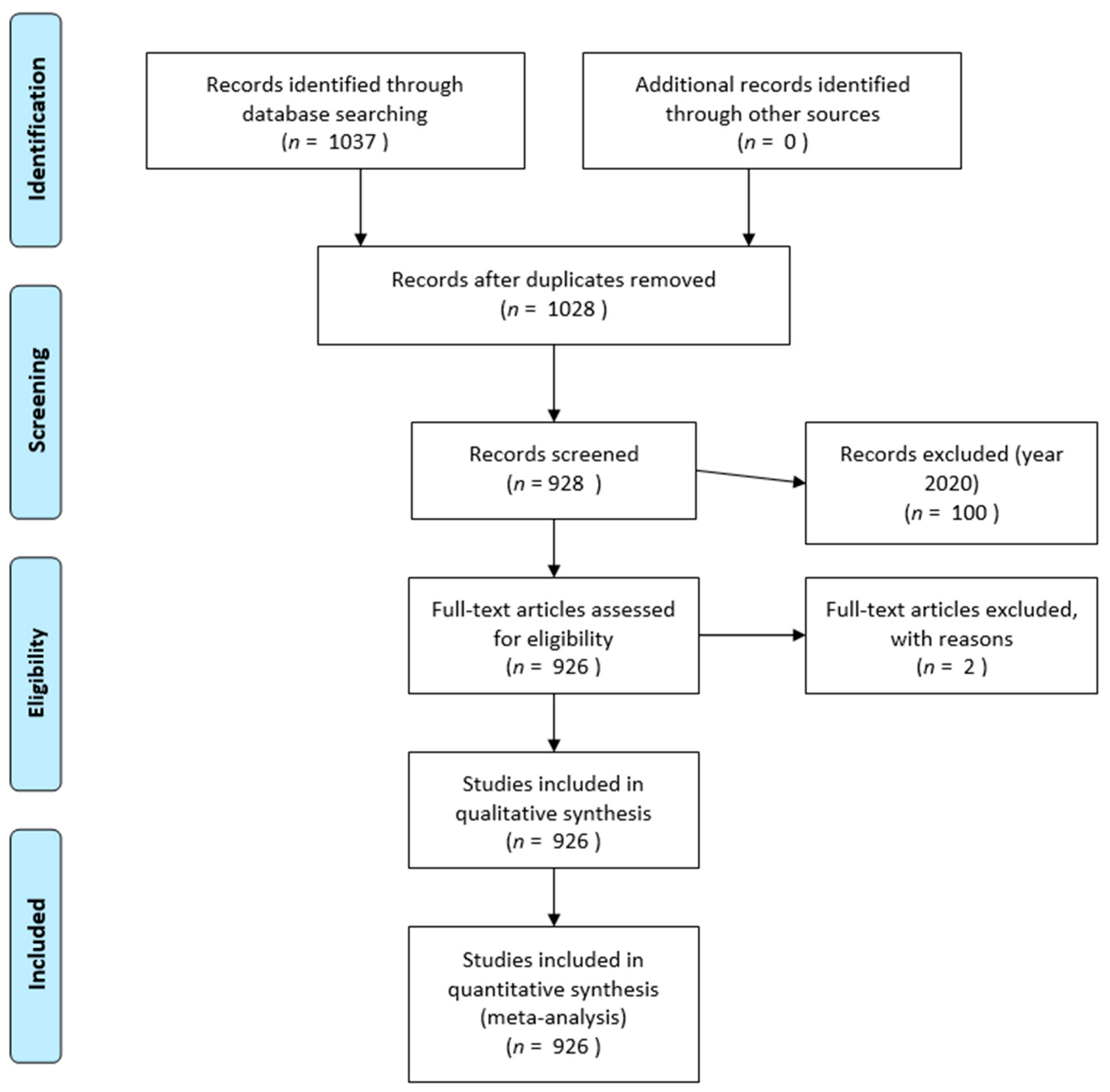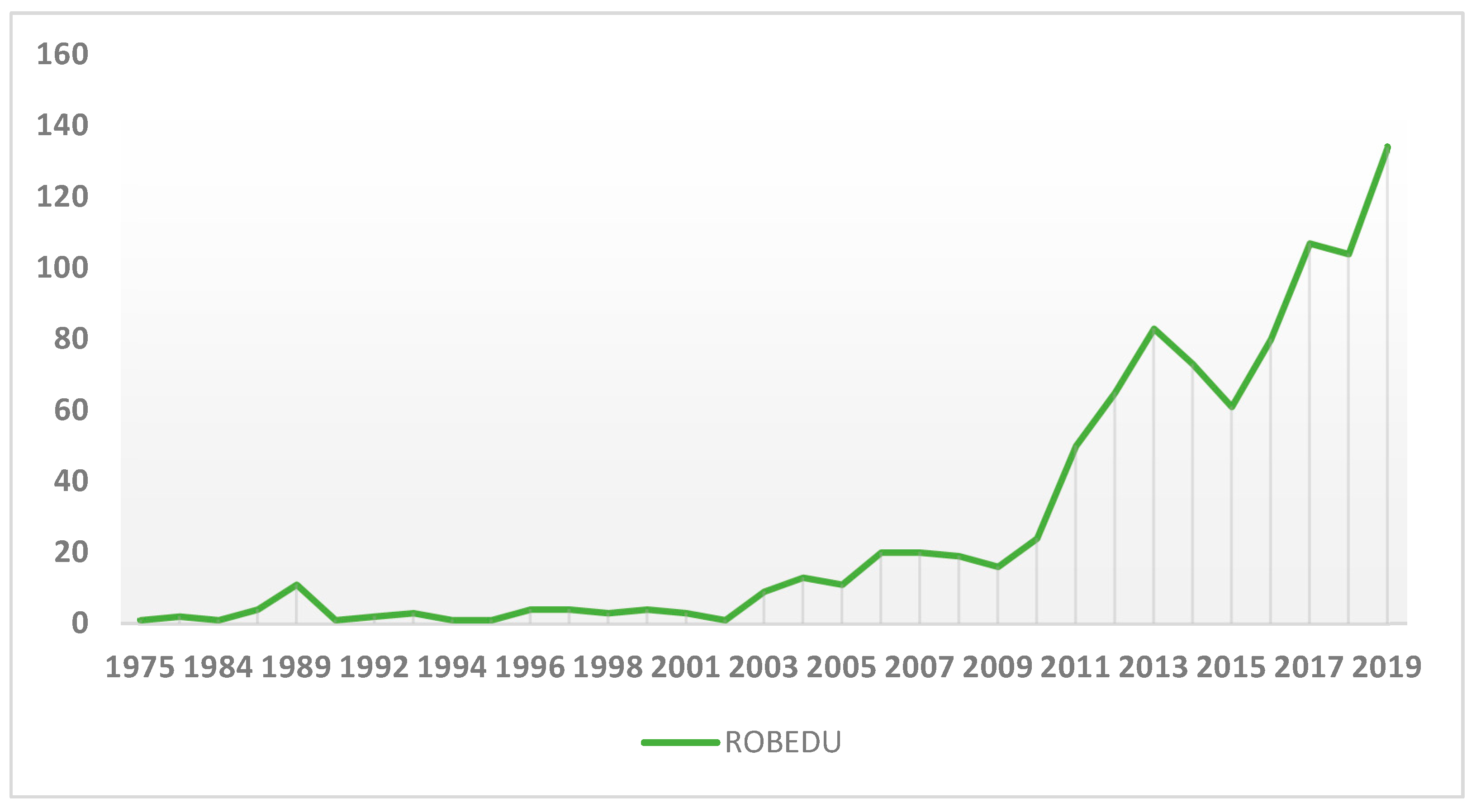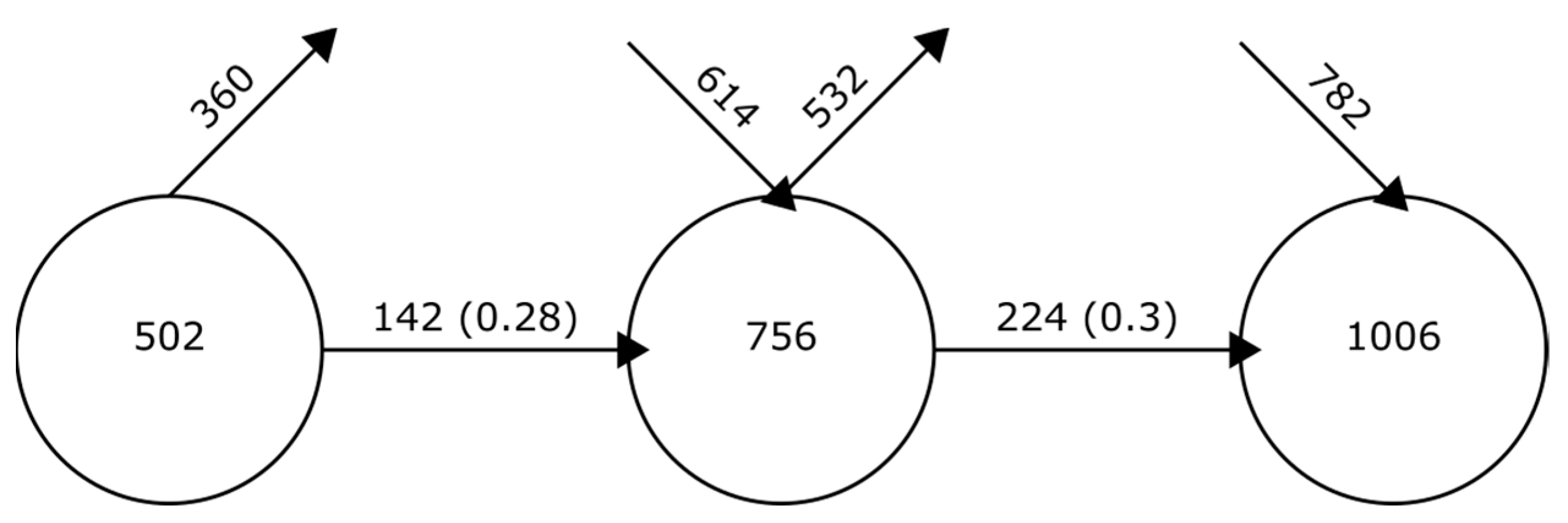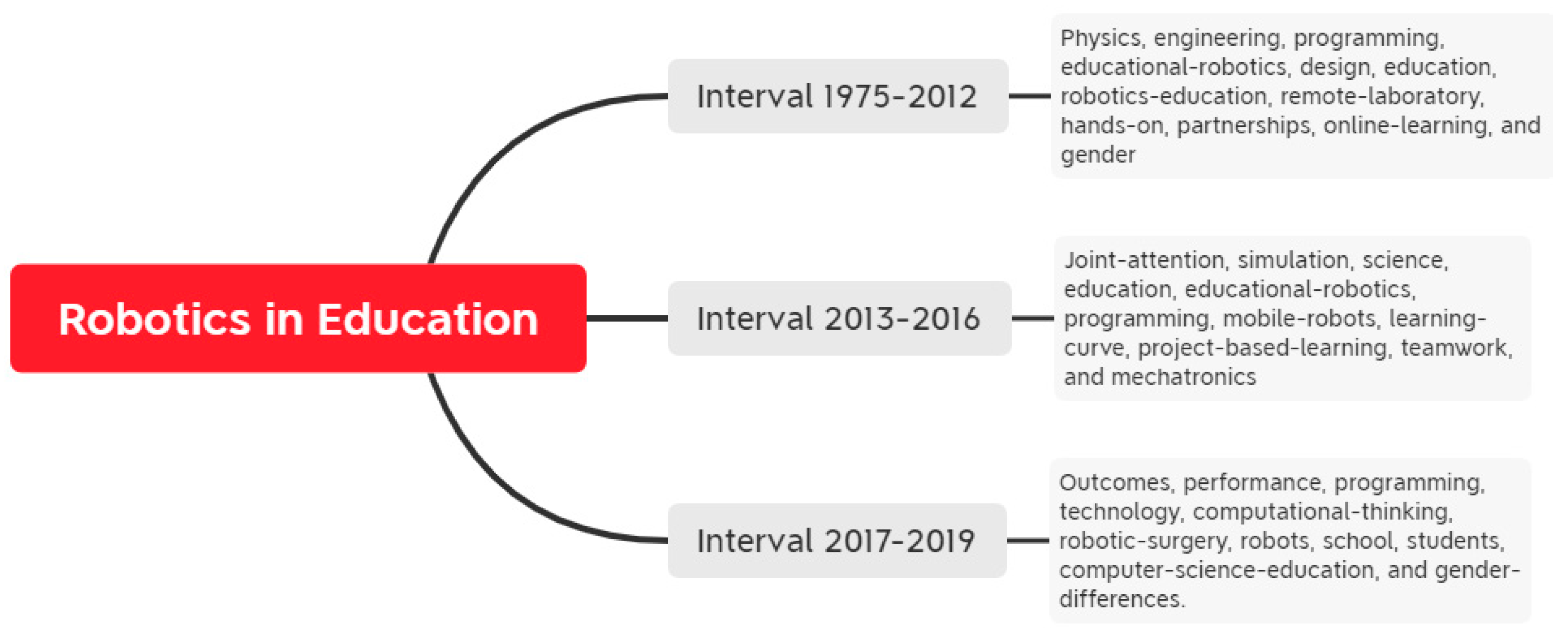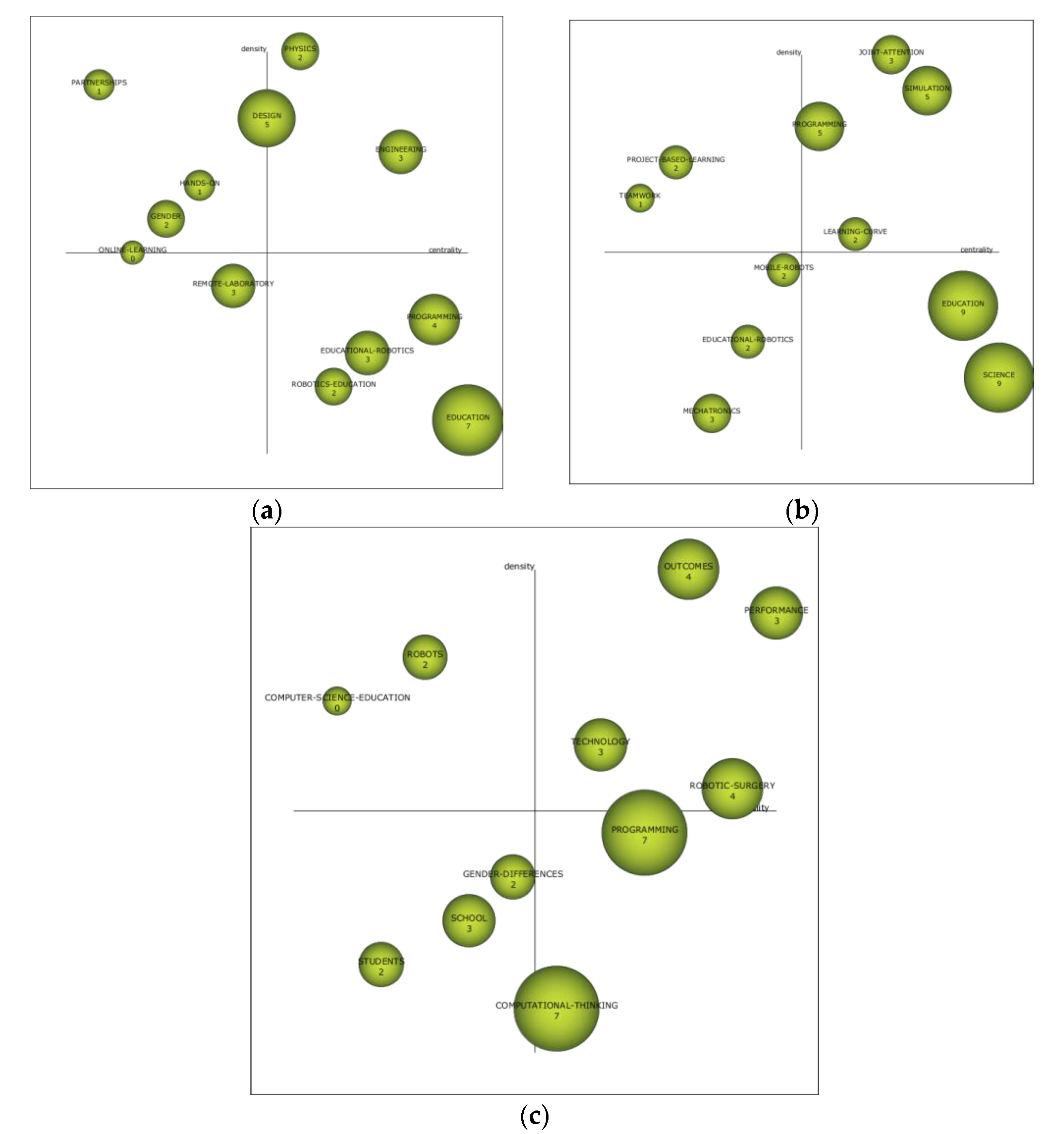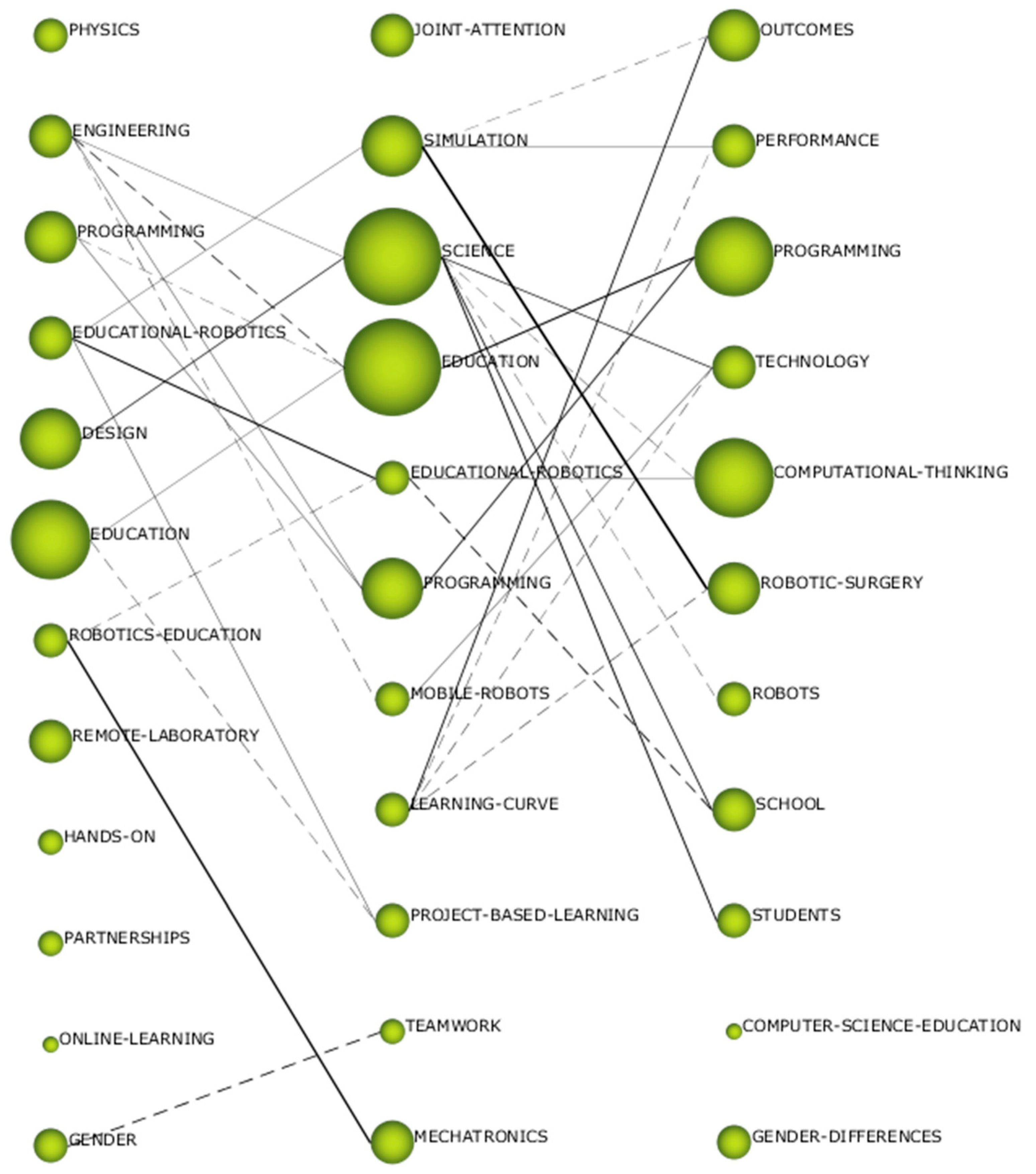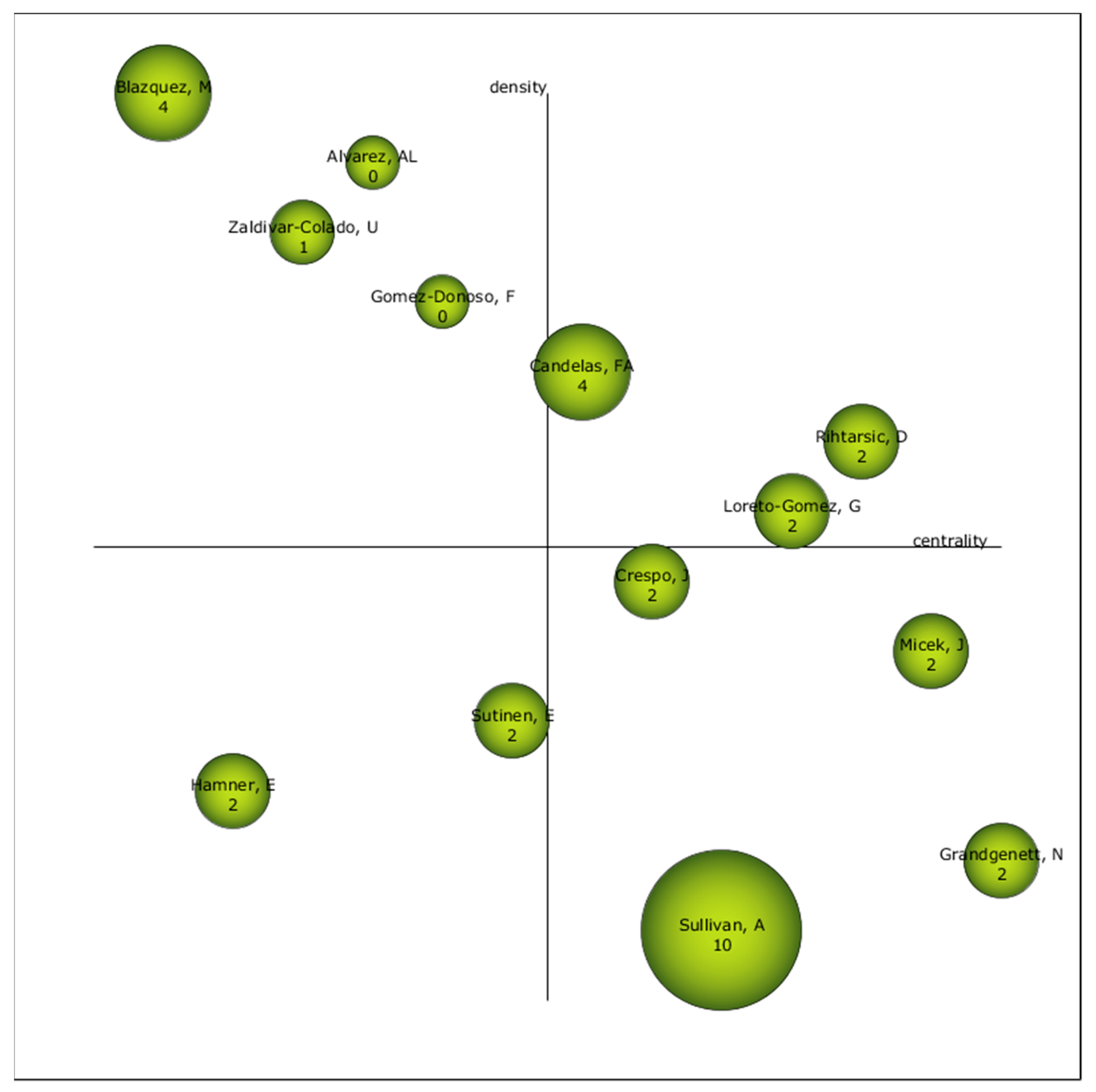1. Introduction
Today’s society is involved in a technological revolution that started in the early 20th century [
1]. This revolution has occurred in the diverse fields in which society is divided, from business, social, and health fields to the educational field. In other words, this technological explosion has deeply changed the way we interact, cure diseases, and learn [
2].
Focusing on the educational field, information technologies have led to a significant, though sometimes slow, change in all current teaching and learning processes [
3]. This technological revolution in education has not always been related to a direct improvement of current teaching and learning processes [
4]. In this regard, the incorporation of different technological tools in any educational process must be related to an improvement of the pedagogical process. As never before, teachers cannot be oblivious to this transformation and should be willing to introduce new tools to help students develop creative, collaborative, and active learning [
5].
Today, there are many methodologies that can help teachers to transform their daily teaching, such as active methodologies [
6], but there are also new tools and devices that allow us to approach the most complex aspects of existing technologies in the educational field, such as robotics [
7,
8].
Robotics have taken on a special interest in today’s education, and the number of educational programs introducing this aspect into their curriculum has grown in recent years, especially in developed countries [
9]. The advantages and potential of introducing these systems in education were detected by several authors more than 20 years ago [
10]. Among the most relevant advantages of this type of system, we found its direct bond with the improvement of learning [
11], the development of specific cognitive skills [
12], or the learning of complex scientific concepts [
13].
The use of robotics in education can be considered from two well-distinguished perspectives. On the one hand, the perspective related to the programming of devices or software and, on the other, that which is associated to the assembly and operation of devices or hardware [
14]. This difference is decisive for posing our activities within the classroom, which must be adapted, as with any technology, depending on the needs of the students [
15]. Though most robotics educational applications focus exclusively on programming or in subjects directly related to technology [
16], the truth is that they can be applied to a much wider range of subjects, such as mathematics, languages, music, or art [
17].
Robotics in education can be seen as an underlying branch of robotics [
18], which focuses on training students in the development, design, and construction of robots [
19]. To do this, students must generate robots by building the robot itself and establishing its capabilities through software [
20].
It can be said that the main purpose of educational robotics is to teach students to design and create a programmable robot [
21] capable of performing various actions, including moving, responding to environmental stimuli, or communicating through sound, light, or images [
22,
23,
24]. In addition, the application of robotics in the educational field involves other associated factors in the education of students [
25], including contributing to the development of logical thinking, psychomotor skills, and spatial perception of students [
26], promoting student autonomy through the development of their own projects [
27] and the active involvement of students in the teaching and learning process [
28], promoting creativity, research, and understanding oriented toward the computer world [
29], generating students’ problem-solving skills [
30], encouraging the development of students’ digital competence [
31], associating it with other pedagogical methods, such as project learning, collaborative learning, or cooperative learning [
32], and encouraging functional learning given that it generates resources that can be applied in the social environment [
33]. Therefore, it can be said that robotics in education generates a series of advantages [
34], including learning to work in a team [
35], increasing self-confidence [
36], promoting entrepreneurship [
37], developing skills [
38], identifying and taking an interest in other disciplines [
39], increasing concentration [
40], increasing creativity [
41], and promoting curiosity and increasing interest in mathematics [
42].
A widely used branch of education for robotics is science, technology, engineering, arts, and mathematics (STEAM) education for training based in these subject areas [
43]. The usual approach when implementing robotics in education is to provide students with robotics kits [
44]. Such a kit should have materials adapted to their age and abilities [
45]. A kit for students aged 6–10 years should not contain the same materials as a kit for students aged 16–18 years [
46]. There are a number of computer resources that allow robotics to be applied in education, including Scratch, Wedo 2.0, Lego Boost, Makey Makey, Arduino, and Microbit [
47,
48,
49,
50]. The application that is used depends on the purpose and capacity of the learners [
51].
It is important to keep in mind that robotics in education can be presented from several perspectives [
52,
53,
54,
55]: learning robotics, where students learn to design, build, and program a robot; learning with robotics, where robots are tools that serve to promote student learning; and robots for education, where the robot is the main tool for the learning process. This last option is related to telepresence in the educational sphere, where robots are used to develop distance learning [
56].
The truth is that robotics in the educational field does not form part of the curriculum today [
57]. This is developed through specific methods during teaching and learning processes or through extracurricular activities [
58]. For robotics to be an integrated part of education systems, a number of aspects must be considered, which may make its inclusion in schools difficult [
59]. These include its high cost [
60], the need to train teachers in the use of technological resources [
61], students’ own digital competence [
62], and the need for the pedagogical training of teachers [
63].
Knowing how the term “robotics” has evolved within the educational scientific literature is therefore a valuable resource for many teachers and researchers. Having a detailed view of its evolution allows us to focus efforts, as teachers and researchers, in specific fields, learn how studies on the subject have advanced, and even detect the rise of new and future research niches.
2. Justification and Objectives
This work arises from the projection that robotics has potential in today’s different learning spaces [
64,
65,
66,
67]. For this reason, this study analyzed the term “robotics” in education (ROBEDU) from a bibliometric aspect of scientific production [
68]. Bibliometry is considered a method of scientific analysis focused on publications on a state of the art. This methodology contributes to revealing to the scientific community, and to all interested readers, the progress and significance of a certain topic or concept throughout history. For this, a series of variables or bibliometric indicators used in the indexing of each study (year, authors, keywords, journal, countries, language, and source of origin being among the most prominent) are taken into account. Therefore, bibliometrics is beneficial as a research methodology as it reveals the journey made by a certain topic [
69]. Another fundamental aspect is the selection of an impact database in order to carry out a pertinent and in-depth study from which interesting results can be obtained, allowing conclusions to be reached and relevant prospects to be considered. In this case, the selected database for the documentary report is the Web of Science (WoS), which is considered to be one of the most relevant databases in the field of social sciences, of which education is a part of it [
70].
In this particular research, an innovative research process has been used. It is about the analysis of documentary performance and the scientific mapping of the literature concerning these concepts. For effective development of the study, the guidelines and models established by experts in this type of research have been followed. This allowed the development of the study to follow an investigative structure for the analysis as well as for the presentation of the data validated by experts [
71,
72].
The purpose of this work was based on the analysis of the evolution of ROBEDU in WoS publications, that is, from when this subject appeared in the scientific literature, its evolution over time, and the concepts to which it is linked. All this is due to a deep analysis of the publications on ROBEDU where the conceptual connections established between the different studies were extracted. This allowed the establishment of not only what has been done so far but also of future trends on this state of the art. As far as our knowledge reaches, and after leading a search in the expert literature, no study analyzing the concept of robotics at a documentary level using these techniques has been reported. In providing a knowledge base, this study will contribute to a reduction in the gap found in the impact literature and to the future work of other researchers. Therefore, this research is positioned under an exploratory and a novel nature. Likewise, this work aims to present to the scientific community the implications and future trends [
73] of this educational technology.
Based on all the above, the objectives formulated in this study were to (1) know the documentary performance of ROBEDU in WoS, (2) establish the scientific evolution of ROBEDU in WoS, (3) find the most significant thematics of ROBEDU in WoS, and (4) trace the most influential authors of ROBEDU in WoS.
4. Results
4.1. Performance and Scientific Production
The production volume of ROBEDU in WoS was 926 manuscripts. The first documents compiled in this database go back to 1975. From that date to 2019, the evolution of this topic was uneven. From 1975 to 1998, production was not continuous, with leaps of years in scientific production. From 2000 to 2010, scientific production was constant but irregular in terms of production volume, which did not exceed 50 products per year. From 2011 onwards, production increased considerably, although unsteadily. From 2011 to 2013, production increased. From 2014 to 2015, the production trend decreased and then increased. This increase in production continued into 2016 and beyond, with a small break in 2018 (
Figure 2).
The manuscripts that deal with ROBEDU were written mainly in English, which accounted for more than 95% of the production. Spanish and Portuguese also appeared but in a very low volume (
Table 2).
There were two knowledge areas that stood out in the ROBEDU field of study. These were “Education Educational Research” and “Education Scientific Disciplines”. The other areas, with lower production levels, were focused on the knowledge areas of engineering and computer science (
Table 3).
The volume of manuscripts generated in conference communications stood out considerably, being higher than the other types of documents. The high production volume of existing research articles was also significant (
Table 4).
There were no major differences between the various institutions worldwide in ROBEDU’s scientific production. The University System of Georgia had the highest volume of production (
Table 5).
As with the institutions, no author stood out above the rest in terms of production volume. Interestingly, several authors had the same volume of scientific production (
Table 6).
In accordance with the type of manuscript, the main source of production was conference proceedings. Among the magazines with the most production, Advances in Intelligent Systems and Computing stood out (
Table 7).
The country with the largest volume of production was the United States. Spain followed with a much smaller volume of production (
Table 8).
The most cited manuscripts, mainly research articles, present a high volume of citations. The most cited manuscript, almost doubling its successor, is [
94]. This work includes a systematic review on the application of robotics in educational centers. The main findings focus on the virtues of this educational technology to improve the learning process, but with caution, since studies have appeared in which there were no improvements. It also offers a series of implications for educators and professionals in this field of knowledge. It is followed by [
95] with 190 citations. This study focuses on revealing the findings achieved after the application of a project that combines robotics with programming in students no more than 4 years old. The main results focus on the improvements produced in the interest and in the learning capacity on topics concerning robotics, its programming and, as a consequence, computational thinking. It is followed by [
96] with 128 citations. In this research, we tried to verify the improvement of the performance of adolescent students through robotics. The students were divided into a control and experimental group. Prepost tests were performed. The findings reflect that students who received a teaching and learning process through robotics obtained better scores than those who did not use it. The fourth most cited article was [
97] with 109 citations. In this work, a hybrid learning experience was carried out in higher education, combining the face-to-face plane with virtuality through content management platforms of a robotic nature. The findings reached determine the demonstrated effectiveness in both learning and performance of university students (
Table 9).
4.2. Structural and Thematic Development
The evolution of keywords in adjacent periods showed a medium-low percentage of coincidence. Between the first period (1975–2011) and the second period (2013–2016), the percentage of coincidence was 28%, and, between the second period (2013–2016) and the third period (2017–2019), the percentage of coincidence was 30%. This indicates that the scientific community is establishing common research bases, though at a low volume. The coincidence percentages show the appearance of new research trends in the ROBEDU field of study (
Figure 3).
Academic performance offers information on the bibliometric values of the thematics resulting from the coword analysis. In the first period (1975–2011), the thematic “education” has the highest bibliometric values. In the second period (2013–2016), the two most prominent thematics have similar bibliometric values. They are “science” and “education”. In the third period (2017–2019), there are also two prominent thematics with similar bibliometric values. In this case, the two thematics are “programming” and “computational-thinking” (
Table 10).
The strategic thematic diagrams, categorized according to the h-index, mark the value and relevance of the various thematics in a set time period. The diagrams are presented on a Cartesian axis. In this case, the
y-axis shows density and the
x-axis shows centrality. Density represents the external relationship of the thematics, while centrality represents the internal relationship. The evolution of the research on robotics in the educational field is represented in
Figure 4.
The data represented in
Figure 5 indicate that in the first period (1975–2012) the motor thematics were “physics”, which is related to “sensors”, “robotic-assisted-teaching”, “interactive-learning-environments”, “camera”, “laboratories”, “learning-environments”, “skills”, and “intelligent-tutoring-systems”; and “engineering”, which is related to “computer-science”, “mathematics”, “nasa”, “competition”, “technology”, “stem”, “science”, and “outreach”. In this period, the most relevant studies were concerned with physics, focused on engineering studies, where active teaching methods based on robotics were applied.
In the second period (2013–2016), the main thematics were “programming”, which is related to “early-childhood”, “concept-mapping”, “prekindergarten”, “engineering”, and “early-childhood-education”; “joint-attention”, which is related to “imitation”, “motor”, “music-therapy”, “behavior”, “young-children”, “autism”, “individuals”, and “rhythm”; “simulation”, which is related to “resident-training”, “robotic-training”, “robotic-prostatectomy”, “surgery”, “face”, “performance”, “robotic-surgery”, and “radical-prostatectomy”; and “learning-curve”, which is related to “validation”, “surgical-education”, “experience”, and “simulator”. In this period, the focus of studies on robotics in education expanded. In this case, the use of robotics was addressed in various educational stages, in the attention of students with special educational needs, and, above all, in the educational field to carry out simulations.
In the third period (2017–2019), the motor thematics were “outcomes”, which is related to “residency-training”, “resection”, “surgical-education”, “learning-curve”, and “minimally-invasive”; “performance”, which is related to “self-efficacy”, “validation”, “surgery-simulator”, “computer-simulation”, “expert”, “virtual-reality”, “stereotypes”, and “girl”; “technology”, which is related to “teaching/learning-strategies”, “perception”, “needs”, “attitudes”, and “choice”; “experience”, which is related to “science” and “elementary-education”; and “robotic-surgery”, which is related to “robotic-training”, “curriculum”, “simulation”, “simulator”, “tool”, “impact”, and “resident-training”. In this period, the line of research established in the previous period was maintained, with added aspects such as simulation, self-efficacy, science, and stereotypes in the use of robotics. In addition, in this period, we must highlight the themes “student”, “school”, and “gender-differences”, which given their position in the diagram can be considered as the future motor thematics of the ROBEDU field of study.
4.3. Thematic Evolution of Terms
The thematic evolution represents the connection between the various themes generated between adjacent periods. This connection can be of two types: conceptual and non-conceptual. The conceptual connection occurs when the two themes represented have a third theme in common. The non-conceptual connection occurs when the connection between themes occurs only through keywords. The conceptual connection is presented with solid lines, and the non-conceptual connection is presented with a broken line. Another feature to bear in mind is the line thickness. The thicker the line is, the more themes or keywords concur between them. This type of connection represents the value and level of coincidences existing in a field of study.
The data shown in
Figure 6 indicate several aspects. Firstly, there is no conceptual gap, as the topic “programming” appears in all periods. Secondly, although the topic “programming” appears in all periods, it cannot be considered to be setting an established and solid line of research in the ROBEDU field of study. In this case, there is no consolidated line in all three periods, though the one established by “educational-robotics–educational-robotics–computational-thinking” may slightly stand out. What can certainly be said is that some strong research lines are starting to be generated, made visible from the second period. This is the case of “simulation–robotic-surgery”, “education–programming”, “science–technology”, “science–school”, and “science–student”. Finally, it can be observed that there are not many connections between themes from adjacent periods; nevertheless, conceptual rather than non-conceptual connections predominate. This shows that there are not many shared lines of research.
4.4. Authors with the Highest Relevance Index
Regarding the authors,
Figure 7 shows that the most relevant are Candelas, F.A., Rihtarsic, D., and Loreto-Gómez, G. In addition, Hamner, E. and Sutinen, E. must be taken into account due to their location in the diagram, which places them as relevant authors in this field of study.
5. Discussion and Conclusions
Technology has changed the way we interact and learn [
1]. Therefore, teachers should include its use in their pedagogical practice as one more element so that students can learn in a collaborative and active manner [
5]. There is a variety of hardware and software that allows the implementation of robotics in the teaching and learning process. As analyzed in other studies, robotics has not yet been implemented in a concrete way in education systems. However, due to the potential it offers for the academic development of students, it will probably be included in the not-too-distant future as a specific subject in various education systems [
25,
26,
27,
28,
29,
30,
31,
32,
33,
34,
35,
36,
37,
38,
39,
40,
41,
47,
48,
49,
50].
Regarding the performance analysis and scientific production on robotics in education, the first publication appeared in 1975. The evolution of the volume of production has been uneven, showing an irregular production from 1975 to 1998. There was a low production of documents between 1975 and 2010. However, scientific production increased from 2010 to 2019, with 2019 having the highest production peak with respect to the thematic.
The most used language for publishing in this field of study is English. Two purely educational publication areas stand out, although engineering and computer science areas also appear in the top positions. One of the most prolific institutions in terms of the thematic is the University System of Georgia; however, other institutions have a similar volume of production. As for the country, the United States is the largest producer of documents.
The types of documents produced are mostly proceedings papers. This indicates that the bases of the investigations are not settled at the time in the form of articles, perhaps showing new lines and trends in the investigation. Regarding the source of production, the minute number of books stands out (matching with the data obtained for the types of documents). The most productive journal in the ROBEDU field of study is
Advances in Intelligent Systems and Computing. As for the authors, several stand out as the highest producers, with the volume of production being nearly the same among the first places. The most prominent relevant authors are Candelas, F.A., Rihtarsic, D., and Loreto-Gómez, G. According to production and evolution, the authors that will probably be relevant in the future are Hamner, E. and Sutinen, E. With regard to citations, the manuscripts on ROBEDU have a considerable volume of citations, among which the most cited manuscript is that of [
42] with 328 citations. In relation to the topics of these works, the most cited manuscript’s topic is about the benefits of this educational technology to improve the learning process [
94], and practical implications for teachers and professionals. The second most cited work’s topic [
95] is about the findings of applying robotics with programming on early stages of education. The third topic or work most cited [
96] is about verifying the improvement of the performance of adolescent students through robotics. Additionally, finally, the fourth most cited article [
97] is about a hybrid learning experience, which was carried out in higher education, combining the face-to-face plane with virtuality through content management platforms of a robotic nature.
On the other hand, in terms of structural and thematic development, the keyword coincidence level between adjacent periods is medium-low. This denotes a lack of established or fixed lines of investigation over time. Academic performance displays changes between the examined periods, moving from focusing on the educational field in general to focusing on science and on programming actions and computational thinking. This corroborates the keyword coincidence, demonstrating that there is no line of investigation established over time.
As for the strategic diagrams, they indicate that during the period between 1975 and 2012, the most relevant investigations pointed toward physics, focused on engineering studies, where active teaching methods based on robotics were applied. Later, in the period between 2013 and 2016, the focus of studies about robotics in education widened. In this case, the use of robotics is addressed in different educational stages, in the attention of students with special educational needs, and especially in the educational field for carrying out simulations. Then, in the period between 2017 and 2019, the line of research previously established is maintained, adding aspects such as simulation, self-efficacy, science, and stereotypes in the use of robotics. In the future, the field of study may focus on the students themselves, schools, and gender differences.
The thematic evolution of terms indicates three main aspects. Firstly, there is no conceptual gap and, therefore, no line of research is recognized in the three periods; however, “educational-robotics–educational-robotics–computational-thinking” is slightly highlighted. Secondly, strong lines of research are observed from the second period onwards, highlighting “simulation–robotic-surgery”, “education–programming”, “science–technology”, “science–school”, and “science–student”. Finally, there are not many connections between themes from adjacent periods, with the conceptual rather than the non-conceptual connections prevailing. This proves that there are not many shared research lines.
As this study has shown, the field of robotics in education has had an increase and consequent upswing in recent years, especially in 2019. Several parameters have shown that no lines of research have been established over time, but, at the same time, there are clues that, recently, the interest in the subject has been increasing. This opens a field of work for researchers on the thematic of robotics and education, which has expanded over recent years in the field of simulation and self-efficacy.
Regarding future prospects, this study shows the potential that the latest studies on the subject have, showing experts, whether researchers and/or teachers, the next path of research on the subject. In addition, a clear systematic review of the robotics and education aspects of recent research in the scientific literature can be carried out.
About the limitations of this study, it should be highlighted that the year 2020 was not included, since the year had not yet finished and the data would therefore not be real. Furthermore, future research could include a coword analysis on topics associated with the study topic.
With regard to the educational implications of this study, based on the analysis carried out, teachers would have the documents on the thematic of robotics and education at their disposal and the relevance that they have had and still have in the educational field. Proof of this is the finding of the use of robotics in various educational stages, in foregrounds particularly, and specifically in the attention of students with special educational needs, in the educational field to carry out simulations, and in self-efficacy with the use of robotics. Given the importance it has for the scientific community in general and teachers in particular, this study paves the way for new lines of work for both teachers and researchers.
